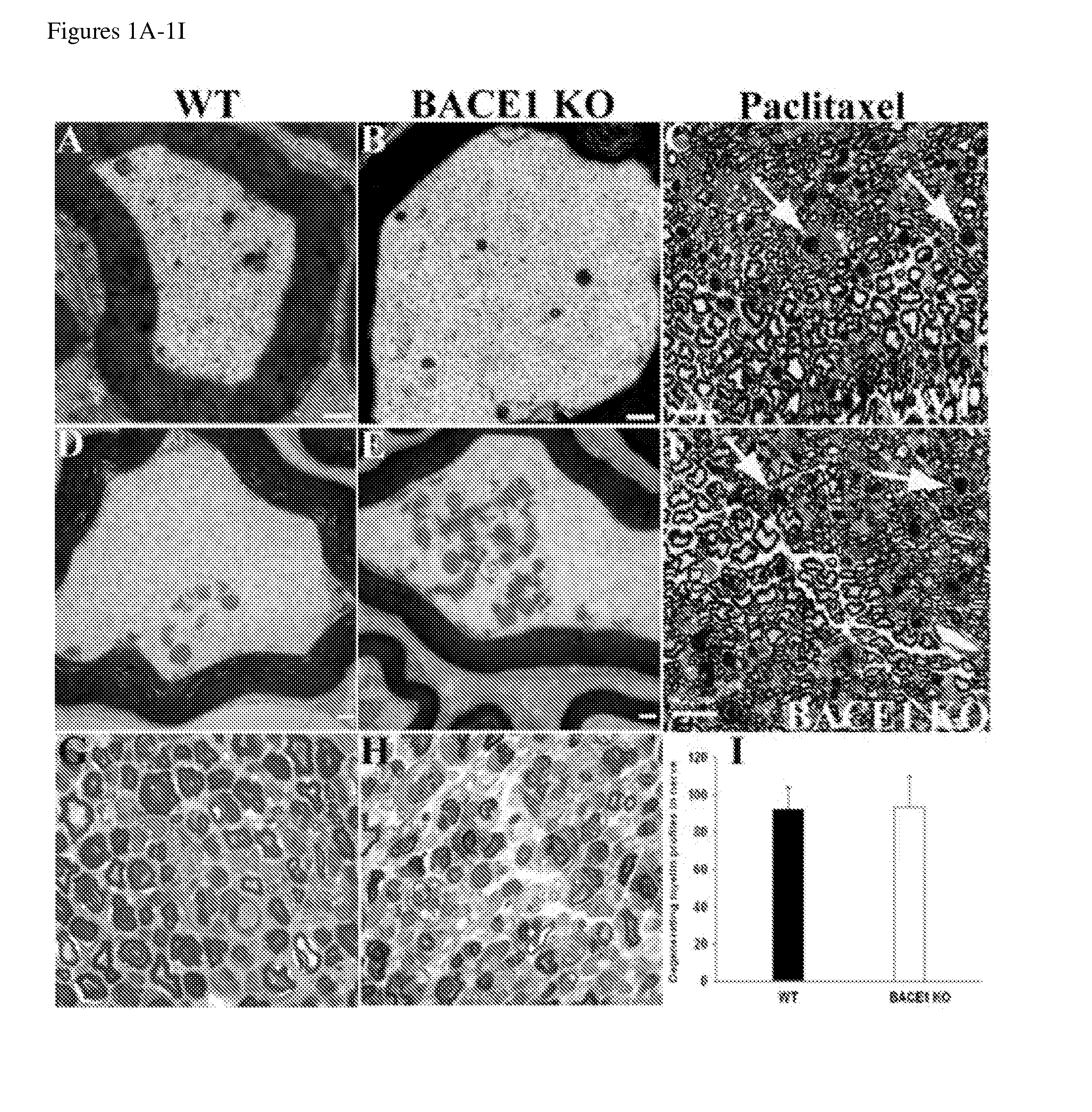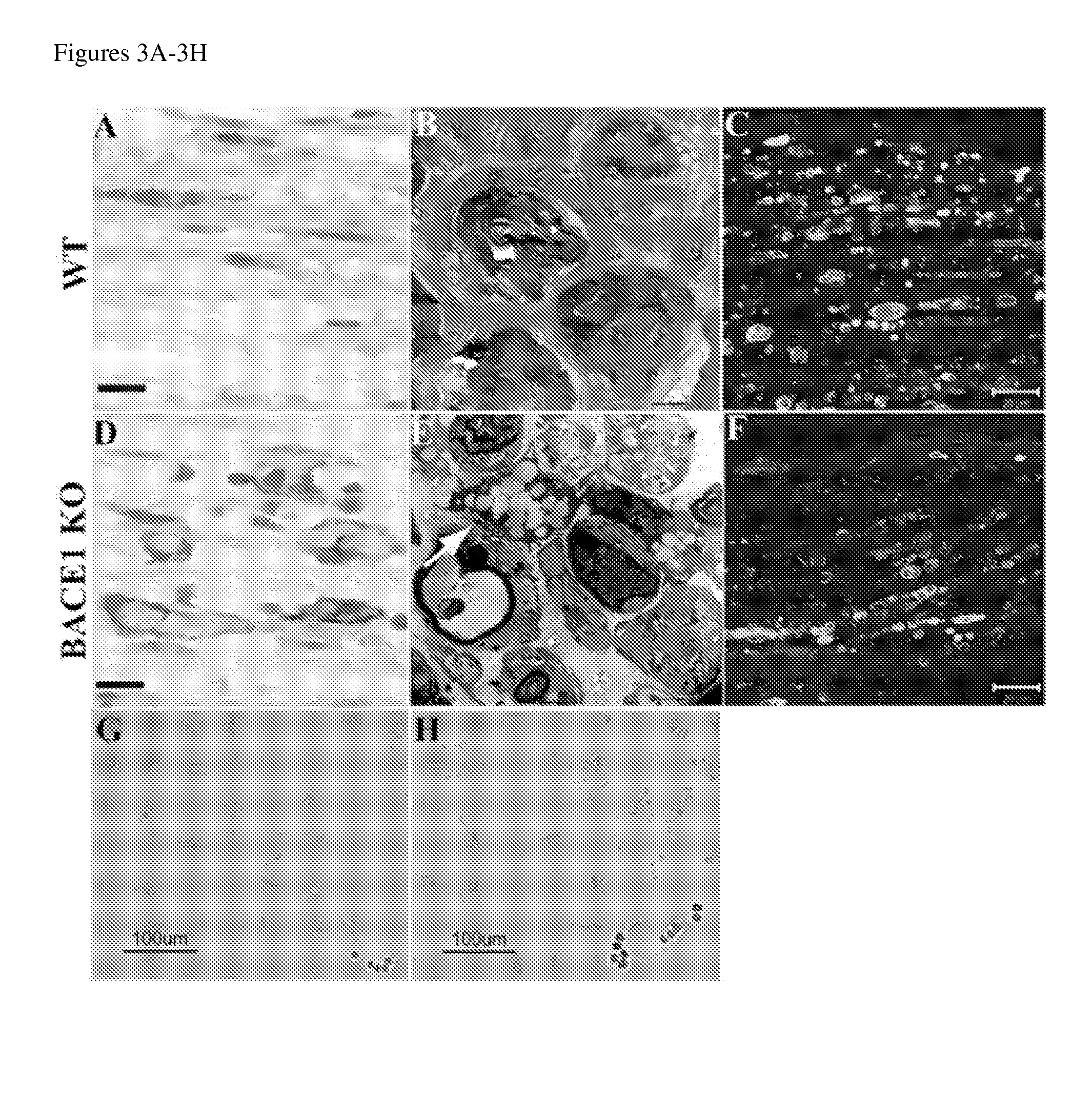Methods for enhancing axonal regeneration
- Summary
- Abstract
- Description
- Claims
- Application Information
AI Technical Summary
Benefits of technology
Problems solved by technology
Method used
Image
Examples
example 1
Lack of Axonal Protection in Wallerian Degeneration and in Paclitaxel- and Acrylamide-Induced Neuropathies in BACE1 KO Mice
[0197]To determine whether genetic deletion of BACE1 could protect axons in adult mice in a fashion similar to that described after growth factor withdrawal during development (Nikolaev et al., Nature 457:981-9 (2009)), BACE1 knockout (KO) mice were evaluated for a delay in Wallerian degeneration after axotomy. As has been previously described (Waller, C.R. Acad. Sci. (Paris) 34:675-679 (1852), Ramon y Cajal, Degeneration and regeneration of the nervous system (Mays ed., 1913); Stoll et al., J. Neurocytol. 18:671-83 (1989); George and Griffin, J. Neurosci. 15:6445-52 (1994); Beirowski et al., J. Neurosci. Methods 134:23-35 (2004); and Beirowski et al., BMC Neurosci. 6:6 (2005)), axons and the myelin surrounding the nerve fibers in the distal segment (the nerve segment beyond the injury) were observed to undergo Wallerian degeneration after transection (FIG. 1). ...
example 2
Accelerated Clearance of Axonal and Myelin Debris in BACE1 KO Mice
[0199]Although the time to initiation of axonal breakdown and to myelin ovoid formation was not different, the subsequent clearance of axonal and myelin debris was markedly faster in the BACE1 KO mice. To evaluate clearance of axonal debris in BACE1 KO nerves, BACE1 KO mice were crossed with mice expressing yellow fluorescent protein (YFP) in a small subset of the axonal population (Feng et al., Neuron 28:41-51 (2000)). Line H was selected from the panel of fluorescent mice lines because it has been previously shown that a small fraction (3%) of the axons are labeled with YFP (Feng et al., 2000; Beirowski et al., Neurosci. 6:6 (2004); 2005; Vargas et al., Proc. Natl. Acad. Sci. USA 107:11993-8 (2010)). Investigating axonal degeneration in nerves marked with YFP had the advantage of allowing whole-mounts of nerves to be analyzed so that the proximal and the whole distal segment of each nerve were visualized throughout ...
example 3
Accelerated Axonal Regeneration in BACE1 KO Mice
[0202]Little axonal growth occurred in either WT littermate or BACE1 KO nerves in the first 2 days after injury, as shown by GAP43 transport, neurobiotin transport, and plastic-embedded transverse sections (data not shown). As this interval represents the latency period (Lanners and Grafstein, Brain Res. 196:547-53 (1980); McQuarrie, J. Comp. Neurol. 231:239-49 (1985); Jacob et al., J. Neurobiol. 24:356-67 (1993); and Seijffers et al., J. Neurosci. 27: 7911-7920 (2007)); the data indicated that inhibition of BACE1 activity does not alter the latency period. Furthermore, the axons had shortening of the latency period in a fashion comparable to that of WT littermate axons when BACE1 KO nerves were condition lesioned (data not shown). However, by day 3 after a single nerve crush, GAP43-positive sprouts had grown farther down the distal stump in the BACE1 KO nerves than in the WT littermate nerves (FIGS. 4A and 4B). The distribution of the...
PUM
| Property | Measurement | Unit |
|---|---|---|
| Biological properties | aaaaa | aaaaa |
| Inhibition | aaaaa | aaaaa |
Abstract
Description
Claims
Application Information
 Login to View More
Login to View More - R&D
- Intellectual Property
- Life Sciences
- Materials
- Tech Scout
- Unparalleled Data Quality
- Higher Quality Content
- 60% Fewer Hallucinations
Browse by: Latest US Patents, China's latest patents, Technical Efficacy Thesaurus, Application Domain, Technology Topic, Popular Technical Reports.
© 2025 PatSnap. All rights reserved.Legal|Privacy policy|Modern Slavery Act Transparency Statement|Sitemap|About US| Contact US: help@patsnap.com



